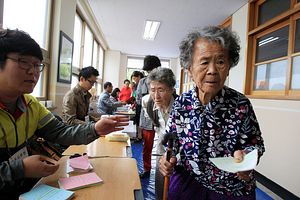It is not new to see rumors about North Korea circulating in South Korea, but the topic of the latest gossip was a bit unusual. It focused on South Korea’s public pension fund, the National Pension Service (NPS).
One rumor says North Korea has recently demanded 200 trillion South Korean won ($177.6 billion) from South Korea in exchange for the denuclearization process, and the South Korean government is considering covering it using the assets of the NPS.
Another rumor says South Korea is planning to merge the NPS with North Korea’s pension system once North and South are reunited.
Although these stories have turned out to be false, these rumors are still being actively shared via different social media channels across the country.
Public interest in such rumors is not a coincidence. These false stories emerged as the Ministry of Health and Welfare, which oversees the NPS, has recently come up with a plan to reform the pension system, which includes raising contributions while decreasing pension amounts and increasing the entry and receiving age for pensions.
The ministry’s plan sparked public outrage, although the government reacted quickly to manage the situation by saying that it is merely a proposal by private experts who are currently providing advice.
The NPS is one of the largest public pension funds in the world. It currently manages about 638 trillion South Korean won ($566.6 billion). It is a mandatory scheme, which means almost every single South Korean citizen depends on this pension for income after retirement.
The issue is that the fund is expected to run dry by 2056. In other words, there will be no money left beyond 2057 to provide pensions to the public. This is because the NPS promises contributors a fixed amount after retirement, and the pension is intended to give more to pensioners than they contributed.
However, low interest rates and an unstable global economy constantly make it difficult for the NPS to generate the required returns. Apart from this, South Korea’s aging society means there are a decreasing number of contributors to the pension scheme.
Discussions about reforming the NPS have been in full swing since the late 1990s — less than 10 years after the introduction of the pension. The first talk of reform came after a similar warning that the pension fund would run dry.
Since then, the government has come up with at least three reform plans, but failed to pursue any of them. That was mainly due to the public backlash, and sometimes, due to political disagreement among the different parties.
Experts point out that the reform of the pension is a national task that cannot be postponed any further. If the government and political parties delay the process of finding a fundamental solution, the whole nation will suffer serious turmoil in the future as the population ages.
Kim Yong-ha at the Korean Social Security Association is among those who believe South Korea should take fundamental, concrete, and dramatic measures to reform the pension.
“It is unfair to say South Korea has not reformed its pension at all. We have progressed slowly according to the situation over the past years. But the trend and situation surrounding the society change more rapidly than before. Reforming efforts also should change accordingly,” said Kim.
“All know that the NPS needs a dramatic reform. Otherwise, there will be no money for pensioners in South Korea. However, people still want to stick with the current pension system. They keep expecting the government to maintain the current system until they retire. After all, who wants to give up a fixed amount of pension in an era of low interest rates where many professional asset managers fail to satisfy their private clients?” he added.
Kim suggests a slightly different solution. He believes the government should not focus on the NPS too much but try to look at other existing pension plans and find a way to take them into consideration.
“Besides the NPS, there are also other types of pension plans in South Korea such as basic pension, retirement pension, and civil servants’ pension. The role of retirement pension can be brought to the NPS and can be adjusted. There is also a way to reduce civil servants’ pensions and bring them into the NPS. If we redesign various social resources comprehensively, we might find more acceptable answers,” Kim says.
“The sooner the NPS improves the system, the smaller the burden on the future. For the sake of a stable future, the government and political parties should leave partisan politics aside and move forward,” he notes.
It is unclear whether the current government actually has a plan to push for reforming the NPS. But, based on the recent plan revealed by the health ministry, many believe it is one of the tasks the government has in mind to pursue. All eyes in South Korea are on the government’s next move.

































